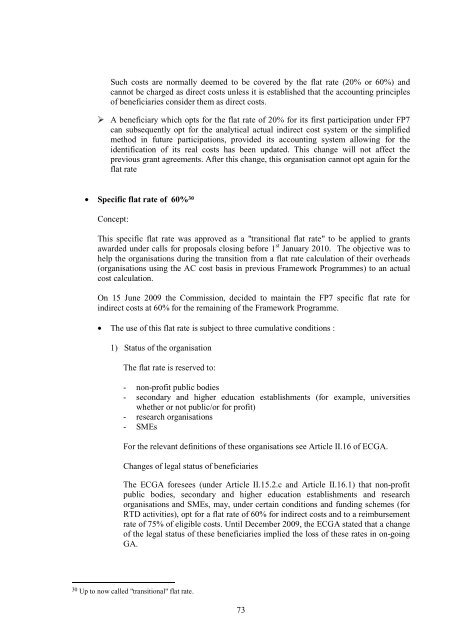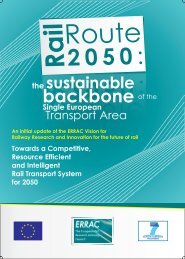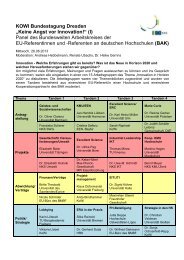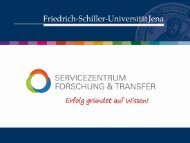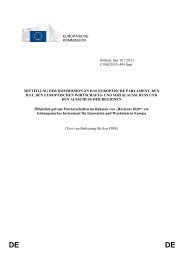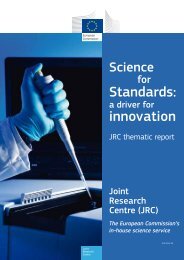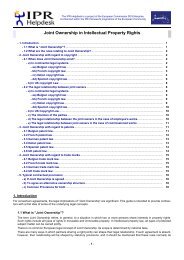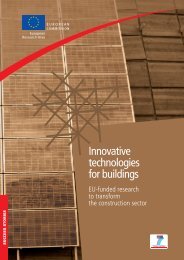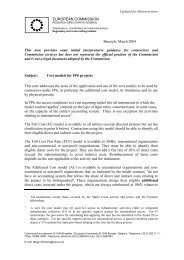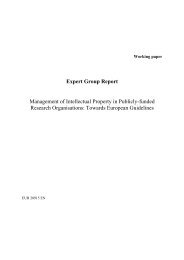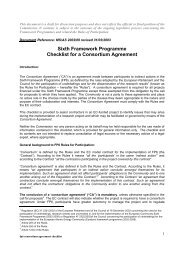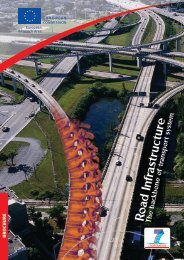Guide to Financial Issues relating to FP7 Indirect Actions - KoWi
Guide to Financial Issues relating to FP7 Indirect Actions - KoWi
Guide to Financial Issues relating to FP7 Indirect Actions - KoWi
You also want an ePaper? Increase the reach of your titles
YUMPU automatically turns print PDFs into web optimized ePapers that Google loves.
Such costs are normally deemed <strong>to</strong> be covered by the flat rate (20% or 60%) and<br />
cannot be charged as direct costs unless it is established that the accounting principles<br />
of beneficiaries consider them as direct costs.<br />
A beneficiary which opts for the flat rate of 20% for its first participation under <strong>FP7</strong><br />
<br />
can subsequently opt for the analytical actual indirect cost system or the simplified<br />
method in future participations, provided its accounting system allowing for the<br />
identification of its real costs has been updated. This change will not affect the<br />
previous grant agreements. After this change, this organisation cannot opt again for the<br />
flat rate<br />
• Specific flat rate of 60% 30<br />
Concept:<br />
This specific flat rate was approved as a "transitional flat rate" <strong>to</strong> be applied <strong>to</strong> grants<br />
awarded under calls for proposals closing before 1 st January 2010. The objective was <strong>to</strong><br />
help the organisations during the transition from a flat rate calculation of their overheads<br />
(organisations using the AC cost basis in previous Framework Programmes) <strong>to</strong> an actual<br />
cost calculation.<br />
On 15 June 2009 the Commission, decided <strong>to</strong> maintain the <strong>FP7</strong> specific flat rate for<br />
indirect costs at 60% for the remaining of the Framework Programme.<br />
• The use of this flat rate is subject <strong>to</strong> three cumulative conditions :<br />
1) Status of the organisation<br />
The flat rate is reserved <strong>to</strong>:<br />
- non-profit public bodies<br />
- secondary and higher education establishments (for example, universities<br />
whether or not public/or for profit)<br />
- research organisations<br />
- SMEs<br />
For the relevant definitions of these organisations see Article II.16 of ECGA.<br />
Changes of legal status of beneficiaries<br />
The ECGA foresees (under Article II.15.2.c and Article II.16.1) that non-profit<br />
public bodies, secondary and higher education establishments and research<br />
organisations and SMEs, may, under certain conditions and funding schemes (for<br />
RTD activities), opt for a flat rate of 60% for indirect costs and <strong>to</strong> a reimbursement<br />
rate of 75% of eligible costs. Until December 2009, the ECGA stated that a change<br />
of the legal status of these beneficiaries implied the loss of these rates in on-going<br />
GA.<br />
30 Up <strong>to</strong> now called "transitional" flat rate.<br />
73


